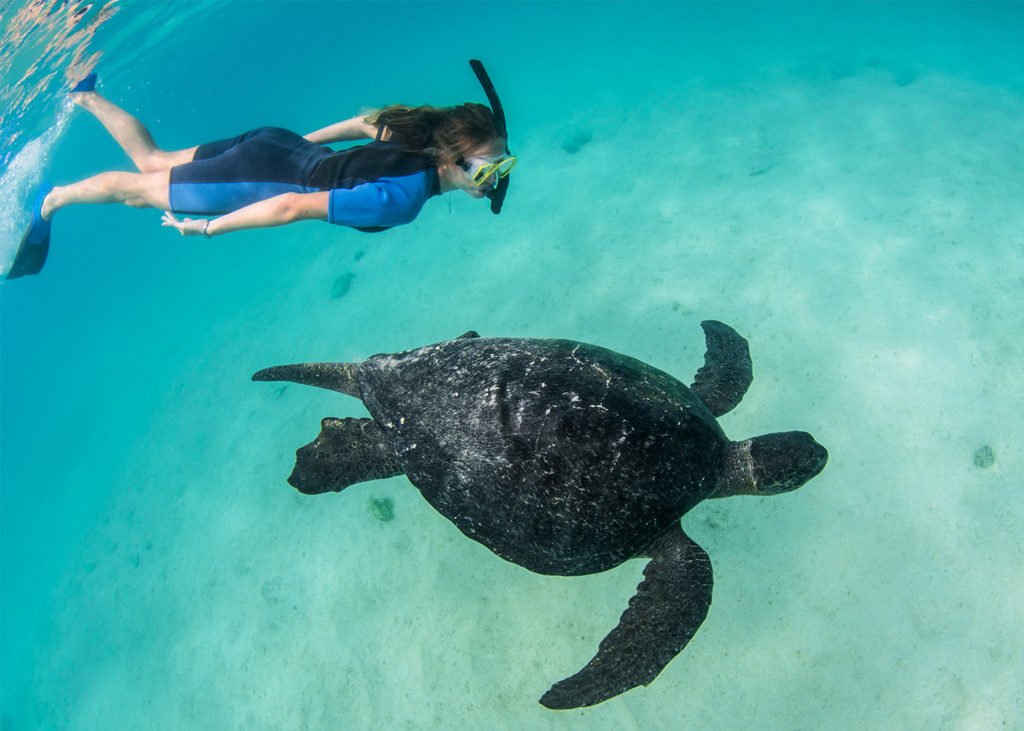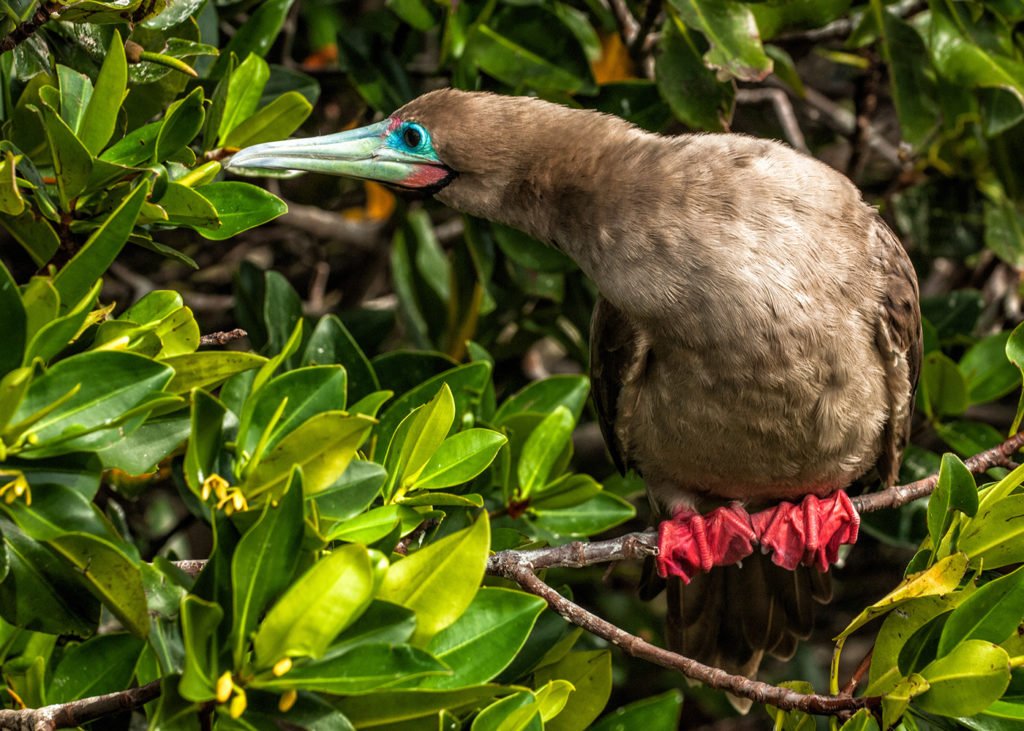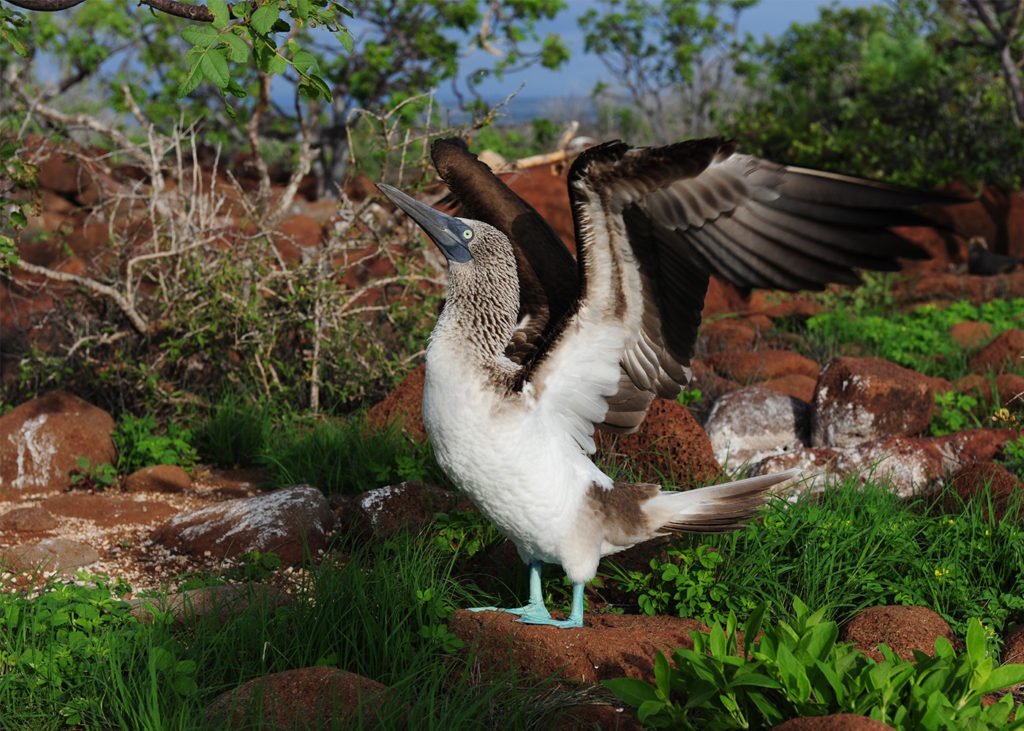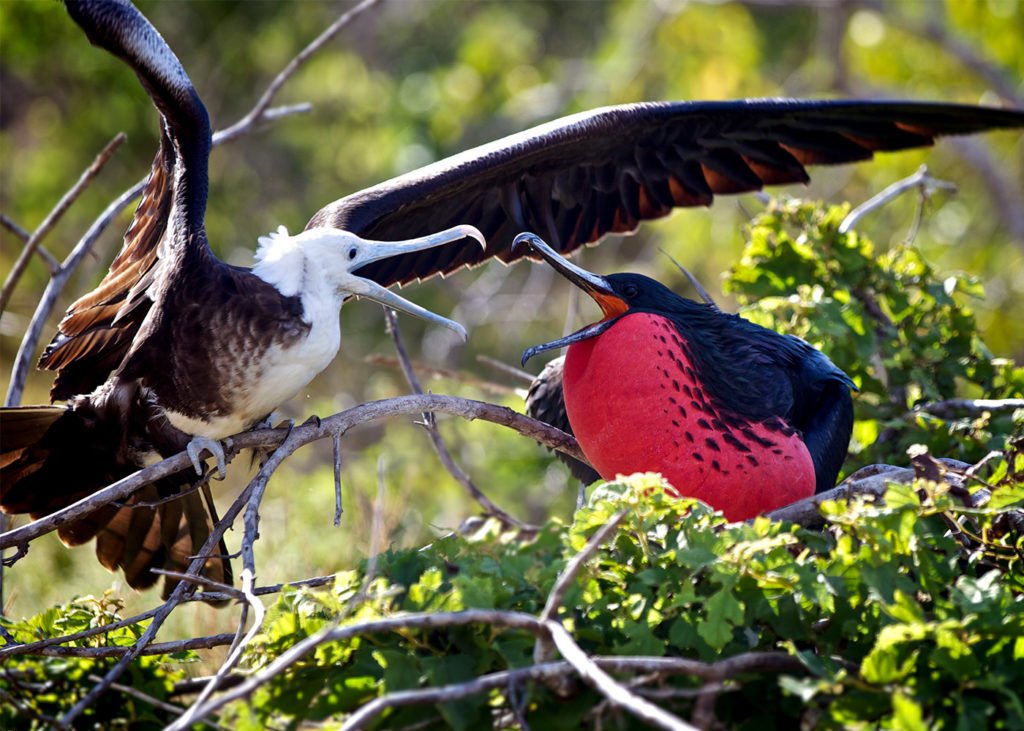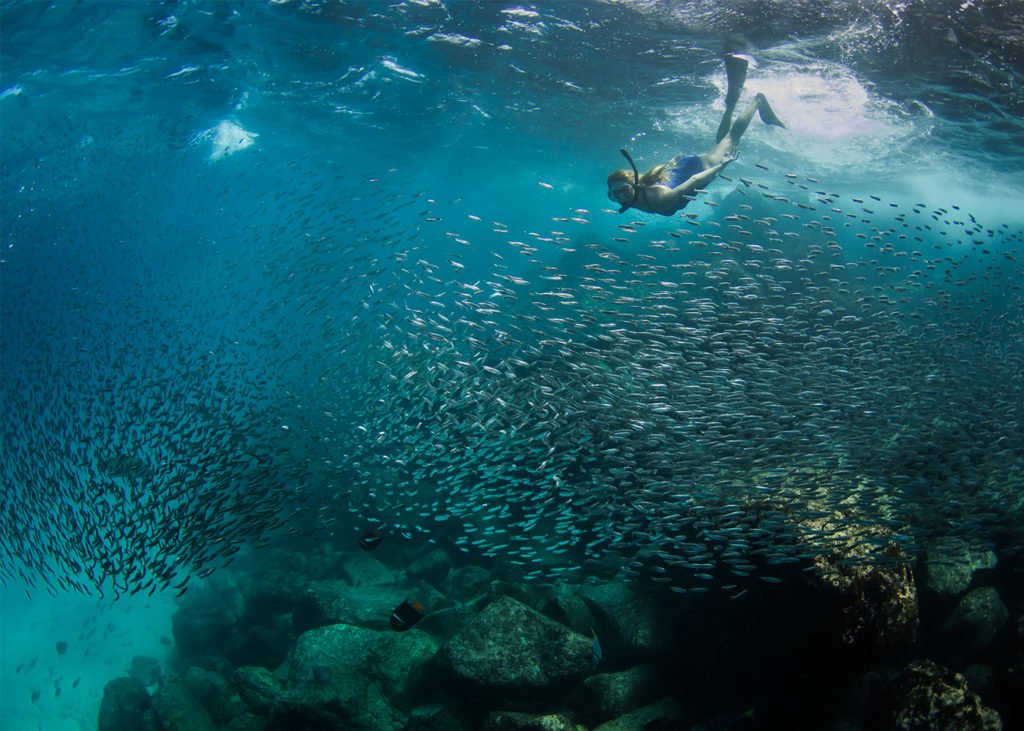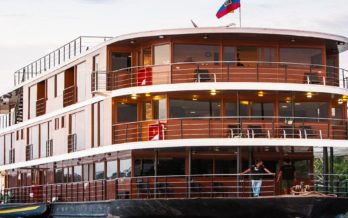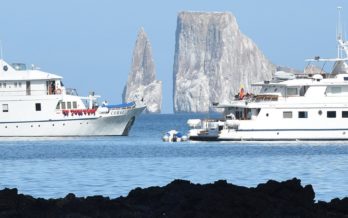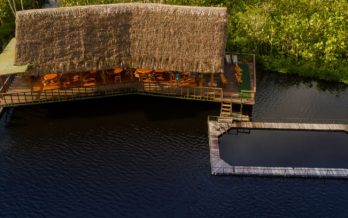Cruise Overview
You can enjoy this paradise, navigating in a 90 passenger cruise 5-star fully air conditioned ship. With all the commodities of a cruise liner yet small enough for that intimate experience with nature that brings you to the Galapagos.
Guests can benefit from the added comfort of extra space in our fully carpeted luxurious cabins. All with ocean views, wardrobes, and private facilities offering hot and cold water, hair dryer, safe deposit boxes and other amenities.
We pride ourselves for having a highly trained hotel and ship crew. In addition the vessel also has the services of a 24 hour duty doctor; and, naturalist multilingual guides.
Other facilities include an auditorium for conferences, spacious social areas, culinary delights at the dining room, 24 hour coffee bar, swimming pool with broad sun decks and observation platforms. At night guests can enjoy live music at the piano lounge, cocktail bars, computers equipped with games and internet access, or keep in touch with family and friends using our long distance call facility.
Cabin Types
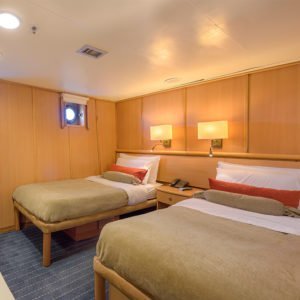
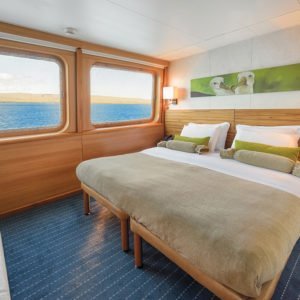
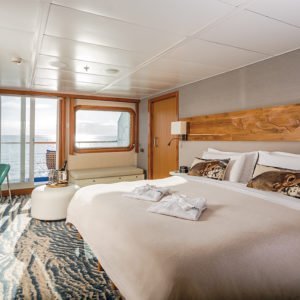
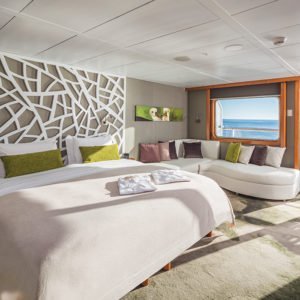
Route Map
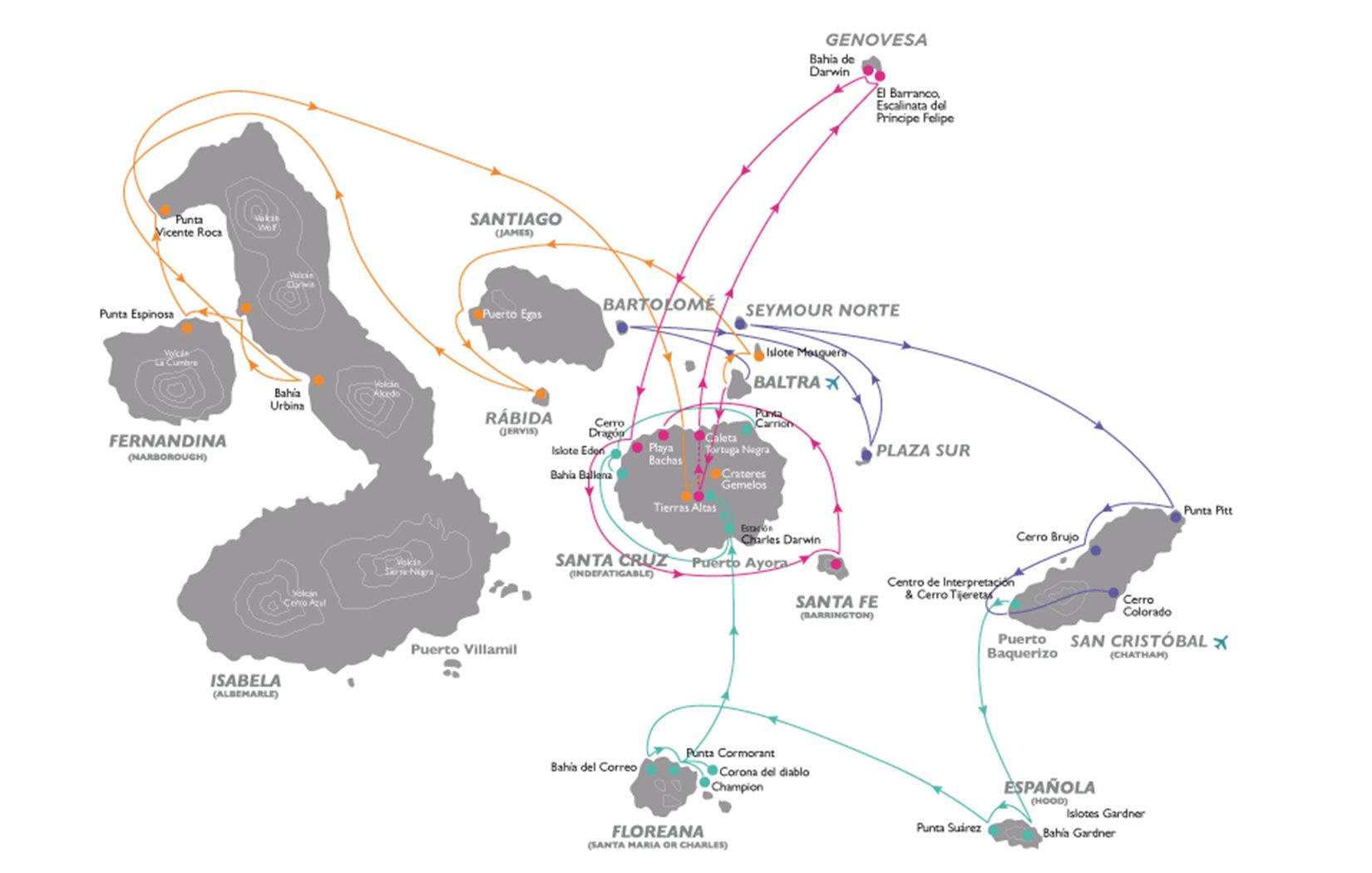
Itinerary A - North Islands
Departs Mondays
Departure from Quito or Guayaquil to Baltra Island (2 ½-hour flight). Arriving in the Galapagos, passengers are picked up at the airport by our natural guides and taken to a ten-minute bus drive to the pier to board the M/V Galapagos Legend.
Afternoon Excursion – Highlands Tortoise Reserve (Santa Cruz Island)
Dry landing. In the mountains of Galapagos is possible to admire different kinds of birds, such as tree and ground finches, vermillion flycatchers, paint-billed crakes, yellow warblers, and cattle egrets (usually standing on the tortoises’ shell). The journey to the reserve offers great opportunities to see the contrasts that the island offers in reference to the variety of ecosystems. The road goes from the coast through the agricultural zone and straight up to the dense humid forests. Often, Galapagos Giant Tortoises are also seen on the way, wandering through pastures in the paddocks. This spot is a bird watchers’ haven since almost every land bird present on the island lives or migrates here.
Morning Excursion: Egas Port (Santiago)
Wet landing on a beach of black volcanic sand, visited by Darwin in 1835. The first section of the trail is comprised of volcanic ash (eroded tuff) and the other half of partially uneven terrain is comprised of volcanic basaltic rock lounging the shoreline.
The unique, truly striking layered terrain of Santiago’s shores is home to a variety of resident and migrant birds, including the bizarre Yellow-crowned Night Heron and astounding array of marine wildlife including lobster, starfish and marine iguanas grazing on algae beds alongside Sally Light-foot Crabs. Colonies of endemic fur seals swimming in cool water pools formed by volcanic rocks are also a highlight.
Afternoon Excursion: Bartolome
Dry or wet landing. We discover a fascinating moonscape* formed by different volcanic parasitic cones —lava bombs, spatter, cinder cones —as we hike to the summit for impressive views of the surrounding islands, including the eroded tuff cone Pinnacle Rock*. We also encounter marine iguanas, lava lizards and blue-footed boobies*.
Beach time is a great opportunity to snorkel and see (perhaps swim with) Galapagos Penguins, sea turtles and White-tipped Reef Sharks among a great variety of colourful fish. For many visitors, this may turn out to be the best of snorkelling experiences*; the water here is generally clear, without too much surf and full of marine life.
Due to its geographical location, the lack of vegetation is immediately noticeable. Pioneer plants are observed, so called because they are the first to establish roots on new ground. They include Tiquilia nesiotica (which is endemic to the island) and Chamaesyce (known as sand mat or spurge in English), lava cactus, and Scalesia bushes. Behind the beach we have dunes covered by mangroves.
Morning Excursion: Dragon Hill (Santa Cruz)
Dry landing. We walk by a brackish lagoon where feeding flamingos can be occasionally found. The trail leads across typical dry zone vegetation* up to Dragon Hill, an important nesting ground for endemic land iguanas*, offering lovely views of the anchorage and neighbouring islands. The forest is home to mockingbirds, Darwin’s finches, Yellow Warblers and Galapagos Doves.
Afternoon Excursion: North Seymour
Dry landing. This is perhaps one of the busiest tourist destinations on the archipelago. Off of Baltra Island (where the airport is located) and not far from Santa Cruz, North Seymour is the most accessible for day trips out of Santa Cruz’s main port, Puerto Ayora.
An approximately two hour walk amidst large nesting colonies of blue-footed boobies*, magnificent and great frigatebirds*, and swallow-tailed gulls for an in depth encounter with sea bird breeding cycles and as well as sea lions. You will also encounter sea lions, land iguanas, and on a lucky day, you might even come across a Galapagos Snake.
Morning Excursion: Bachas Beach (Santa Cruz)
Wet landing on the north side of Santa Cruz; behind the beach lie two small flamingo ponds with iguanas, coastal birds, Darwin finches, mockingbirds, and gulls, as well as interesting native and endemic vegetation, red and black mangroves, salt bushes, and much more. This beach is one of the main nesting sites of sea turtles* in the Galapagos. A female can lay eggs 3 or 4 times with an average of 70 eggs each, but then spend 3 or 5 years without breeding.
At this paradisiacal site we will also find the remains of barges that sank long ago, once property of the United States Navy when they operated an airbase on Baltra Island during World War II. That is why the beach is called “Bachas” because the word “barges” in English was hard to pronounce for the local people.
Baltra airport
Transfer to the airport for return flight to Guayaquil or Quito.
Itinerary B - West Islands
Departs Thursdays
On arrival, you will be met by the naturalist guides and taken on a ten minute bus drive to the pier to board the M/V Galapagos Legend.
Afternoon Excursion: Black Turtle Cove (Santa Cruz Island)
On the north shore of Santa Cruz Island, accessible only by sea where four species of mangrove crowd from the shore out into the lagoon, turtle enjoy swimming in the calm waters, peaking their heads above the surface while fish, rays and small sharks circle below. White-tipped reef sharks can be seen beneath the boat, sea birds, including pelicans, herons and egrets, all feed in the cove. This cove has been declared as a “Turtle Sanctuary”.
Morning Excursion: Egas Port (Santiago Island)
Wet landing. Egas Port is a black volcanic sand beach, visited by Darwin in 1835. The first section of the trail is formed of volcanic ash (eroded tuff) and the other half is an uneven terrain of volcanic basaltic rock. The unique, truly striking layered terrain of Santiago shore is home to a variety of animals including the bizarre yellow-crowned night heron and marine wildlife including lobster, starfish and marine iguanas grazing on algae beds alongside Sally light-foot crabs. It is easy to see colonies of endemic fur seals swimming in cool water volcanic rock pools.
Afternoon Excursion: Rabida Island
Wet landing. Dark-red sand covers the unique beaches of this island, home of sea lions colonies; Rabida is considered the epicentre of the Galápagos Islands due to the diversity of its volcanic geology. Nesting brown pelicans are found from July through September plus nine species of the famous Darwin’s finches. Here a dinghy ride along marine cliffs is done, to observe nesting seabirds. Snorkel off the coast, where marine life is particularly active.
Morning Excursion: Urbina Bay (Isabela Island)
Wet landing on a volcanic “black” beach. Depending on the season, we may find giant tortoises, land iguanas and the unusual Flightless Cormorant. After a short walk inland, snorkelling time is allotted, giving you yet another chance to swim with sea turtles, sea lions and countless tropical fish. Urbina Bay features a wide variety of plant life that changes depending on the season. We can observe the beautiful colours of plants that attract different insects, birds and reptiles. We will explore the uplifted coral reef that resulted from 1954 volcanic activity, with a spectacular view of Alcedo Volcano.
Afternoon Excursion: Tagus Cove (Isabela Island)
Dry landing on Galápagos’ largest island where we will learn about the eruption of the five volcanoes that form it. The trail leads to Darwin’s salt-water Crater Lake and excellent views of lava fields and volcanic formations.
We will return by the same path for a dinghy ride along a shoreline full of marine wildlife, where we will admire a variety of seabirds, such as Blue-footed Booby, Brown Noddy, terns, Flightless Cormorant and depending on the season, a large number of Galápagos Penguins which are only 35 cm. Tall; the only penguin species in the world to extend its range into the northern hemisphere along the equator. They are monogamous and lay their eggs in small cracks of lava, on the lower parts of the island near the shoreline not reached by the ocean waves.
The population of penguins on the islands is about 2,000 individuals, most of which live on this western portion of Isabela; others are scattered further south on the island. We will have an opportunity to snorkel in deep water. Graffiti believed to have been left by19th-century pirates is a curious reminder of an intriguing past.
Morning Excursion: Fernandina Island
Dry landing. Espinosa Point is the only spot that we visit on Fernandina, and from it we can see the island of Isabela across the Bolívar Channel, an area that boasts some of the highest diversity of endemic sea fauna in the found mingling with sea lions and Sally Lightfoot Crabs; a wonderful opportunity to encounter Flightless Cormorants at their nesting sites, Galápagos Penguins and the “King” of predators on the Islands, the Galápagos Hawk. “Pa-hoe-hoe” and “AA” lava formations cover the majority of the terrain. Vegetation is thus scarce inland, but we encounter Brachycereus cacti and extensive mangrove beds lining the shores.
Afternoon Excursion: Isabela Island
Great deep-water snorkelling at one of the richest marine havens on Earth (Bolívar Channel). We take a dinghy ride along the coast to observe a great diversity of sea and coastal birds. The upwelling of coldwater currents in this part of the Galápagos gives rise to an abundance of marine life.
Morning Excursion: Santa Cruz Island
Dry landing. A 45-minute bus ride will take us to the Santa Cruz highlands, located to the northwest of Puerto Ayora, where we will find a natural reserve with giant tortoises. These enormous and slow-moving reptiles are responsible for the island’s name and therefore approaching them in their humid and forested abode is always an inspiring adventure. They can weigh between 250 and 300 kg and can live up to 150-200 years.
Baltra
Afterwards, transfer to the airport for your flight back to the mainland.
Itinerary C - East Islands
Departs Mondays
Morning Excursion: Baltra Airport
Departure from Quito or Guayaquil to Baltra (2½-hour hour flight). In Baltra, passengers are picked up at the airport by our naturalist guides and taken on a ten-minute bus drive to the pier to board the M/V Galapagos Legend.
Afternoon Excursion: Bartolome
Dry or wet landing. We discover a fascinating landscape formed by different volcanic parasitic cones —lava bombs, spatter, cinder cones — that resembles the moon. Going up to the summit there will be impressive views of the surrounding islands, including the eroded tuff cone Pinnacle Rock. We also encounter marine iguanas, lava lizards, and blue-footed boobies.
Beach time is a great opportunity to do snorkelling and see the famous Galapagos Penguins, sea turtles and White-tipped Reef Sharks among a great variety of colourful fish. For many visitors, this may turn out to be the best snorkelling experience. Crystal clear water is the perfect spot to appreciate the incredible marine life it has to offer.
Due to its geographical location, the lack of vegetation is immediately noticeable however, there are pioneer plants including the endemic Tiquilia nesiotica and Chamaesyce (known as sand mat or spurge in English), lava cactus, and Scalesia bushes.
Morning Excursion: South Plaza Islet
Dry landing on the northern part of the Islet. The walk begins with an impressive cactus forest* surrounded by land and marine iguanas; as we reach its highest point, be on the lookout for tropicbirds, a Nazca and blue-footed boobies, swallow-tailed gulls.
In South Plaza there is a large colony of the smaller sized land iguanas. Approximately, there is a population of 300 individuals. They feed on all kinds of vegetation, but during the dry season survive on the fruits and flowers of Opuntia cacti. Due to their proximity with marine iguanas, this is the only place on Earth where we will find the Galapagos hybrid iguana.
Afternoon Excursion: North Seymour Island
Dry landing. Off of Baltra Island and not far from Santa Cruz, North Seymour is located.
This landmass was formed by a series of underwater volcanic eruptions, which deposited layers of lava on the ocean floor. An approximately two-hour walk amidst large nesting colonies of blue-footed boobies, magnificent and great frigate birds, and swallow-tailed gulls for an in depth encounter with sea bird breeding cycles and sea lions. You will also encounter land iguanas, and on a lucky day, you might even come across the endemic Galapagos Snake.
Morning Excursion: Pitt Point / Pitt Islet (San Cristobal Island)
Wet landing followed by a high intensity hike on rocky terrain. The trail includes an olivine beach of 90 meters long and a path that climbs to the top of a volcanic tuff, through several magnificent viewpoints*. This is probably the only site where the three booby species* of the Galapagos can be seen together, as well as two species of frigatebirds* and a sea lion colony; it is also excellent for dinghy rides and snorkelling, where a good range of sea birds can be observed.
Afternoon Excursion: Cerro Brujo (San Cristobal Island)
Wet landing. Cerro Brujo is an eroding tuff cone* that at several locations is composed of AA lava formations, and a beautiful white sand beach*, great for snorkelling and sunbathing. We visit a lagoon where migratory bird* species can be seen: Black-necked Stilts, Ruddy Turnstones, Whimbrels, other sandpiper species and White-cheeked Pintails. Cerro Brujo offers beautiful views of Kicker Rock, the southern part of San Cristobal and the adjacent coast.
Morning Excursion: San Cristobal Island
Dry landing in Puerto Baquerizo Moreno. You will visit the San Cristobal giant tortoise Breeding Centre to learn about the National Parks’ conservation program. You will also have the opportunity to visit the port village, have a drink or shop for arts and crafts and other souvenirs.
Afterwards, transfer to San Cristobal airport for you flight back to the mainland.
Itinerary D - South Islands
Departs Thursdays
On arrival, you will be met by the naturalist guide and transferred to the port to board the Legend.
Afternoon Excursion: Interpretation Centre & Tijeretas Hill (San Cristóbal Island)
Dry landing in Puerto Baquerizo Moreno, capital of the Galapagos Islands. Passengers visit the Interpretation Centre, an excellent place to learn about Natural History in the Galapagos*. The Museum of Natural History displays information on the volcanic origins of the islands, their remoteness from the continent, ocean currents, climate, the arrival of the different species and their colonization, among other points of interest. The human history is also showcased, chronologically narrating the most significant events related to the discovery and colonization of the islands. Tijeretas Hill involves a high intensity walk amidst beautiful landscapes and a magnificent view at the foot of a frigatebird nesting colony.
Morning Excursion: Gardner Bay, Gardner & Osborn islets (Española Island)
Wet landing on a beautiful white coral sand beach guarded by a colony of sea lions. There are no trails, so we stay along the shore where we can spot Galápagos hawks, American Oystercatchers, Galápagos Ground Doves, Hood mockingbirds, Yellow Warblers, lava lizards, marine iguanas, and three species of Darwin’s finches: a subspecies (Geospiza fuliginosa) of the Large Cactus Finch, which is similar to the large ground finch, the Small Ground Finch (Geospiza fuliginosa) and the Warbler Finch (Certhidea Olivacea), another endemic subspecies. Swimming and snorkelling offer a great variety of Galápagos marine wildlife: king angelfish, Creole fish, damsel fish, parrotfish, manta rays, and white-tipped reef sharks.
Afternoon Excursion: Suarez Point (Española Island)
Dry landing. An island of geological interest, we explore volcanic formations and a riveting wildlife: large sea lion colonies and seabirds including Española mockingbird,
Nazca Boobies and the spectacular Red-billed Tropicbird. You will also encounter marine iguanas, lava lizards, and the colourful Sally Lightfoot Crabs.
A somewhat lengthy hike will bring you among Nazca and Blue-footed Boobies, right up to nesting grounds that sometimes overlap the trail. Other birding favourites include Galápagos Dove, Galápagos Hawk, Swallow-tailed Gulls and the world’s largest colony of Waved Albatross, an unequivocal highlight during mating season (May-December).
Admire the island’s dramatic backdrop, featuring the famous Soplador, a seaward blowhole that shoots water some 23 m. (75 ft.) in the air.
Morning Excursion: Post Office (Floreana Island)
Wet landing. Located on the north side of Floreana, the bay is so-named because in 1793 Captain James Colnett installed a wooden barrel which served as an informal post office for sailors passing through, who would take letters with them to their destinations. Today, our visitors continue the tradition by placing unstamped postcards inside the barrel that should reach their destinations for free. It can take weeks, months, even years, not arrive at all, or even arrive before you!
We may also encounter Darwin’s finches, Yellow Warbler and lava lizards. Great snorkelling opportunities with Green Pacific Sea Turtles as well, this island is best known for its endemic vegetation: Scalesia villosa, Lecocarpus pinnatifidus, and Galápagos milkwort. Snorkelers can practice on the main beach among playful sea lions.
Afternoon Excursion: Cormorant Point / Devil’s Crown / Champion (Floreana Island)
Wet landing, on an olivine green sand beach. We hike from the black mangrove beds to a brackish lagoon, which usually holds one of the largest flamingo populations in the Galápagos. This island features some endemic plants such as Scalesia villosa, white and black mangrove, and holy stick. The trail continues to a beautiful white-sand beach, one of the most important nesting sites of Green Pacific Sea Turtles. It is important to avoid walking in the water due to the Sting Rays that may be hiding in the sand, which can be dangerous if accidentally stepped on. From the beach one can spot sea turtles, Blue-footed Boobies plunging into the water, and small reef sharks floating along the shoreline in search of food.
This coral-sand beach marks the end of our trail, and we head back to the olivine beach we landed on to swim or snorkel amongst sea turtles, reef fish, sea lions and, on a good day, white-tipped reef sharks. A small colony of penguins resides on Floreana and can sometimes be observed as well.
Morning Excursion: Highlands (Santa Cruz Island)
Dry landing. A 45-minute bus ride will take us to the Santa Cruz highlands, located to the northwest of Puerto Ayora, where we will find a natural reserve with giant tortoises. These enormous and slow-moving reptiles are responsible for the island’s name and therefore approaching them in their humid and forested abode is always an inspiring adventure. They can weigh between 250 and 300 kg and can live up to 150-200 years. Additionally, travellers can walk inside surprising lava tubes.
Afternoon Excursion: Fausto Llerena Breeding Center – Charles Darwin Station(Santa Cruz Island)
Dry landing. We visit the Station where the Galápagos giant tortoise breeding program takes place as part of our efforts to preserve the fragile Galápagos environment and where the famous Lonesome George (the last surviving specimen of his specie) lived for decades. Admire a prickly-pear cactus forest and variety Darwin’s finches and other land birds. The Darwin Station also works providing environmental education to communities and schools within the islands, and to tourists visiting the Galápagos Islands. You will also have some free time to visit the town and shop for souvenirs.
Morning Excursion – Carrion Point (Santa Cruz Island)
This is a rocky cliff offers the great opportunity to explore more the various marine biodiversity of the islands. Do snorkelling among a variety of colourful fish, stingrays, and if lucky, there could be the chance to see the magnificent White tipped shark.
Baltra Airport
After the visit, passengers will be transferred to the airport for their return flight to Guayaquil or Quito.
Tour Inclusions
- All shore excursions and activities throughout the voyage by Zodiacs and trails.
- Accommodation
- All meals on board the ship.
- Ground transportation in the islands and baggage handling between the island airports and the ship.
- Guided excursions.
- Rates per person
